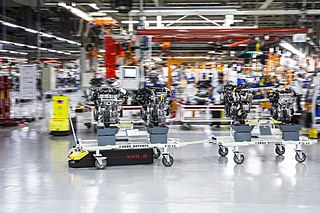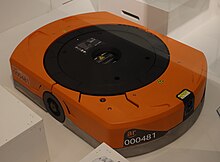
Amazon.com, Inc., doing business as Amazon, is an American multinational technology company, engaged in e-commerce, cloud computing, online advertising, digital streaming, and artificial intelligence. It is considered one of the Big Five American technology companies; the other four are Alphabet, Apple, Meta, and Microsoft.

Automation describes a wide range of technologies that reduce human intervention in processes, mainly by predetermining decision criteria, subprocess relationships, and related actions, as well as embodying those predeterminations in machines. Automation has been achieved by various means including mechanical, hydraulic, pneumatic, electrical, electronic devices, and computers, usually in combination. Complicated systems, such as modern factories, airplanes, and ships typically use combinations of all of these techniques. The benefit of automation includes labor savings, reducing waste, savings in electricity costs, savings in material costs, and improvements to quality, accuracy, and precision.

Logistics automation is the application of computer software or automated machinery to improve the efficiency of logistics operations. Typically this refers to operations within a warehouse or distribution center, with broader tasks undertaken by supply chain engineering systems and enterprise resource planning systems.

An automated guided vehicle (AGV), different from an autonomous mobile robot (AMR), is a portable robot that follows along marked long lines or wires on the floor, or uses radio waves, vision cameras, magnets, or lasers for navigation. They are most often used in industrial applications to transport heavy materials around a large industrial building, such as a factory or warehouse. Application of the automatic guided vehicle broadened during the late 20th century.

A mobile robot is an automatic machine that is capable of locomotion. Mobile robotics is usually considered to be a subfield of robotics and information engineering.

An automated storage and retrieval system consists of a variety of computer-controlled systems for automatically placing and retrieving loads from defined storage locations. Automated storage and retrieval systems (AS/RS) are typically used in applications where:
Order processing is the process or work-flow associated with the picking, packing, and delivery of the packed items to a shipping carrier and is a key element of order fulfillment. Order processing operations or facilities are commonly called “distribution centers” or “DC 's”. There are wide variances in the level of automation associating to the “pick-pack-and-ship” process, ranging from completely manual and paper-driven to highly automated and completely mechanized; computer systems overseeing this process are generally referred to as Warehouse Management Systems or “WMS”.
An online grocer is a supermarket or grocery store that allows ordering via websites or mobile apps. The order can either be collected by the customer or delivered to the customer by drivers engaged by the grocer, a food delivery service, or by delivery drones and robots.
Gilt is an American online shopping launched in 2007. On January 7, 2016, The company was sold to Hudson's Bay Company for approximately $250 million. Prior to the Hudson's Bay acquisition, sales were exceeding growth projections but the firm had not been profitable yet. On June 4, 2018, Boston, Massachusetts-based Rue La La acquired Gilt from Hudson's Bay.
Harvest Automation, Inc. is a robotics company headquartered in Billerica, Massachusetts, that manufactures small, mobile material handling robots for nursery, greenhouse and eCommerce fulfillment applications.

Raffaello D’Andrea is a Canadian-Italian-Swiss engineer, artist, and entrepreneur. He is professor of dynamic systems and control at ETH Zurich. He is a co-founder of Kiva Systems, and the founder of Verity, an innovator in autonomous drones. He was the faculty advisor and system architect of the Cornell Robot Soccer Team, four time world champions at the annual RoboCup competition. He is a new media artist, whose work includes The Table, the Robotic Chair, and Flight Assembled Architecture. In 2013, D’Andrea co-founded ROBO Global, which launched the world's first exchange traded fund focused entirely on the theme of robotics and AI. ROBO Global was acquired by VettaFi in 2023.
Michael C. "Mick" Mountz is an American entrepreneur. He is the founder and CEO of Kiva Systems, which makes order fulfillment systems using mobile robots for warehouse automation. The company was bought by Amazon.com in March 2012.

An automated convenience store is a convenience store that operates without a cashier, and instead relies on computers and robotics.
Vecna Robotics, Inc. is an American robotics and technology company headquartered in Waltham, Massachusetts. Incorporated in 2018 as a spin-off from Vecna Technologies, the company specializes in automated material handling, hybrid fulfillment and workflow optimization for industrial applications.
Bruce Welty is an American entrepreneur and businessman who designs and builds warehouse management systems (wms) and e-commerce order fulfillment systems. Welty is a founder of AllPoints Systems, Inc., Quiet Logistics, Inc., and Locus Robotics Corporation. He is the former chairman of the board for Locus and former chief executive officer and chairman of the board for Quiet Logistics. Mr. Welty holds 11 patents. His media appearances include 60 Minutes, CNN, CNBC and Bloomberg News.
Quiet Logistics is a third-party logistics (3PL) company headquartered in Devens, Massachusetts. Quiet specializes in providing order fulfillment and returns management services to e-commerce retailers. In November 2021, American Eagle Outfitters announced that it would acquire Quiet Logistics for $350 million in cash.
Amazon Scout is a 6 wheeled delivery robot used to deliver packages for multinational company Amazon. Amazon Scout originally debuted on January 23, 2019, delivering packages to Amazon customers in Snohomish County, Washington. Amazon scouts move on sidewalks, at a walking pace. In August, 2019, the robots started delivering packages to customers Irvine, California on a test basis, with human monitors. The package is stored inside of the robot, and driven to the customer.
Attabotics is a robotics company based in Calgary, Alberta, Canada that specializes in Automated Storage and Retrieval System (AS/RS) inventory management systems. Founded in 2016, the company designs and manufactures intelligent robots that operate within a modular, three-dimensional storage structure that minimizes the traditional fulfillment center footprint.
Berkshire Grey, Inc. is an American technology company based in Bedford Massachusetts that develops integrated artificial intelligence (“AI") and robotic solutions for e-commerce, retail replenishment, and logistics. The company's systems automate pick, pack and sort operations.










